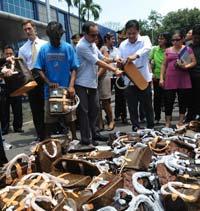Nation cited as major source of fake goods

The Philippines has become a treasure-trove of fakes from pirated video and music DVDs to popular international brands such as Rolex, Gucci, Christian Dior, Louis Vuitton and Lacoste
Despite a government crackdown, hawkers of fake products continue to proliferate in the Philippines - inside shopping malls, on sidewalks, outside hotels and even inside office buildings.
Last month, Louis Vuitton of France, the famed maker of luxurious fashion items, in its campaign to stop the distribution and sale of counterfeit products seized and destroyed about $35 million worth of bogus Louis Vuitton products.
The destroyed counterfeits were seized from shopping malls, retail outlets and warehouses in and around Metro Manila.
This was followed with a raid by The Bureau of Customs (BoC) which seized tens of thousands of dollars worth of counterfeited branded footwear—including imitation Nike and Lacoste shoes—in Manila.
The actions comes as a new study of the anti-corruption group Transparency International (TI) showed The Philippines to be among several developing countries which are said to be major sources of goods involved in transnational crimes.
The Berlin-based organization, which early this year also placed the Philippines in the 11th spot of developing countries with the biggest losses on illicit trades, said the Philippines is among the sources of goods for the illicit trade on counterfeit items, human organs, oil, and gold.
TI looked into 11 different “criminal markets,” which also include drugs, wildlife, humans, small arms, diamond and colored gemstones, timber, fish and art and cultural property.
It placed the trade at $639 to $651 billion.
The illicit trades “originate primarily in developing countries, thrive in the space created by poverty, inequality, and state weakness, and contribute to forestalling economic prosperity for billions of people in countries across the world.”
“Though data is scarce and experts are constantly debating the relative merits and weaknesses of every new study, it is generally accepted that illicit drug trafficking and counterfeiting are the two most valuable markets. This report finds the illicit drug trade to be worth roughly $320 billion and counterfeiting $250 billion. These numbers reflect the potential for huge profits which is the fundamental driver of criminal trade,” it said.
“These criminal flows can do immeasurable structural damage to developing economies by empowering forces which erode the capacity of the state,” it added.
TI said that while most counterfeit goods are produced in China, production can also be found in the Philippines, Taiwan, Vietnam, Malaysia, India, Russia and other former Soviet republics, as well as countries in Latin America and Africa.
Counterfeit goods are then shipped, often through free trade zones like Dubai, to their final destinations in the United States, the European Union, or where there is demand.
Shipping through free trade zones allows the origins of the goods to be disguised, and also provides a chance for “unbranded products to be decorated with the appropriate logos close to the destination market,” noted TI.
“Once the goods get through customs at their destination they are shipped to a warehouse for ‘storing, repackaging and distribution.’ This provides another opportunity for labels to be put on anything that has not yet been branded,” it added.
TI toted that an Interpol report estimates global commercial losses due to counterfeiting at $500 billion, while another, published by OECD in 2009, suggests that the annual value of internationally traded counterfeit and pirated goods could be around $250 billion.
For organ sale, the Philippines is among the “common donors” of these organs together with China, India, Turkey, Egypt, Moldova, Romania, Brazil, Bolivia, and Peru for buyers coming from developed countries like the United States, Canada, Japan, Italy, and Australia, as well as the wealthy classes from developing countries such as Saudi Arabia, Israel, and Oman.
Kidney is the most commonly transplanted organ, with a global estimate of 68,500 transplants performed per year, followed by the liver (20,100), heart (5,200), lung (3,250), and pancreas (2,800).
Illicit trade in kidney and liver alone is estimated to reach between $600 million and $1.2 billion per year.
“As with other forms of trafficking, the illegal kidney trade generally ‘flows from poor, underdeveloped countries to rich, developed ones’... Recently China, Pakistan, and the Philippines have taken steps to prohibit ‘transplant tourism,’ which the United Network for Organ Sharing defines as ‘the purchase of a transplant organ abroad that includes access to an organ while bypassing laws, rules, or processes of any or all countries involved.’ These efforts have dramatically slowed the practice of open transplant tourism, but experts believe that the practice continues as ‘an underground criminal activity,’” TI said.






